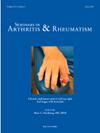免疫抑制疗法治疗系统性硬化症患者新诊断的原发性心脏受累:一项意大利心脏磁共振研究。
IF 4.6
2区 医学
Q1 RHEUMATOLOGY
引用次数: 0
摘要
背景:原发性心脏受累(pHI)在系统性硬化症(SSc)中很常见,并与不良预后相关。治疗SSc-pHI的治疗策略尚未确定。目的:评价免疫抑制治疗对CMR证实的SSc-pHI患者心脏磁共振(CMR)特征的影响。方法:对CMR证实为pHI的SSc患者的数据进行分析,这些患者开始或修改免疫抑制治疗作为新诊断pHI的指征,并在6至18个月后进行了参数映射的CMR随访。所有患者都接受了疾病特征和器官受累的综合基线评估。在所有患者中,在基线和CMR随访时调查心脏受累情况,评估:STIR图像、原生t1和t2定位、细胞外体积分数(ECV)和晚期钆增强(LGE)的心肌水肿。结果:在684例SSc患者队列中,35例(5.1%)SSc- phi(女性77.1%;中位年龄59岁[46-64]岁;抗拓扑异构酶i阳性48.6%;弥漫性疾病(34.3%)。在大多数基线CMR患者(74.3%)中,发现了活动性心肌炎症的迹象(STIR水肿和/或t2定位增加)。15例(42.9%)患者开始使用霉酚酸酯(MMF), 7例(20.0%)患者增加使用;7例患者(20.0%)接受利妥昔单抗治疗,3例患者(8.6%)接受硫唑嘌呤治疗,3例患者分别接受环磷酰胺(脉冲类固醇)、托珠单抗和羟氯喹(类固醇)治疗。免疫抑制的中位持续时间为12.0[6.0-15.5]个月。在随访CMR(中位时间12.0[6.5-16.0]个月后进行)中,只有14例患者(40%)(p = 0.003)出现t2p升高,提示心肌炎症活动,只有5例患者(14.3%)出现STIR水肿(p = 0.002)。T2-mapping(从53.0[49.0-55.0]降至51.0 [50.0-54.0]ms, p < 0.001)、原生t1 -mapping(从1050.0[1007.0-1084.0]降至1039.0 [1020.5-1080.5]ms, p = 0.022)和ECV(从34.0[31.0-36.75]降至33.0 [29.0-34.25]%,p = 0.041)显著降低,尤其是基线mapping增加的患者(T2-mapping从53.0[53.0-56.0]降至52.0 [50.0-57.0]ms;t1映射从1066.0[1050.0-1089.0]到1057.0 [1027.5-1090.0]ms, p < 0.0001。CMR特征的改善与NT-proBNP (p = 0.008)、高敏感肌钙蛋白T (p = 0.003)和c反应蛋白(p = 0.010)的显著降低并行。无治疗相关不良事件记录。结论:我们的数据表明,免疫抑制是一种治疗SSc-pHI的潜在治疗策略,可以抑制CMR时心肌炎症的迹象,并显著降低心脏酶、炎症标志物和总体临床负担。需要更大规模的前瞻性随机研究来证实这些数据。本文章由计算机程序翻译,如有差异,请以英文原文为准。
Immunosuppressive therapy to treat newly diagnosed primary heart involvement in patients with systemic sclerosis: An Italian cardiac magnetic resonance based study
Background
Primary heart involvement (pHI) is frequent in systemic sclerosis (SSc), and is associated with a poor prognosis. Therapeutic strategies to treat SSc-pHI are not yet defined.
Objectives
To evaluate the efficacy of immunosuppressive therapy on cardiac magnetic resonance (CMR) features in patients with CMR-proven SSc-pHI.
Methods
The data from SSc patients with CMR-proven pHI who start or modify immunosuppressive therapy as indication for the newly diagnosed pHI and who had a follow-up CMR with parametric mapping after 6 to 18 months were analyzed. All patients underwent a comprehensive baseline evaluation of disease characteristics and organ involvement. In all patients, cardiac involvement was investigated at baseline and at follow up with CMR, evaluating: myocardial edema at STIR images, native-T1 and T2-mapping, extracellular volume fraction (ECV), and late gadoliunum enhancement (LGE). A p value <0.05 was considered as statistically significant.
Results
Out of a cohort of 684 SSc patients, 35 (5.1 %) with SSc-pHI (females 77.1 %; median age 59 [46–64] years; anti-topoisomerase-I positivity 48.6 %; diffuse disease 34.3 %) were selected. In the majority of patients (74.3 %) at baseline CMR, signs of active myocardial inflammation (edema at STIR and/or increased T2-mapping) were found. Mycophenolate mofetil (MMF) was started in 15 (42.9 %) or increased in 7 (20.0 %) cases; 7 patients (20.0 %) received rituximab, 3 (8.6 %) azathioprine, while 3 patients were treated each one with cyclophosphamide (with pulse steroids), tocilizumab and hydroxychloroquine (with steroids). The median duration of immunosuppression was 12.0 [6.0–15.5] months. At follow-up CMR (performed after a median time 12.0 [6.5–16.0] months), increased T2-mapping suggestive for active myocardial inflammation was present in only 14 patients (40 %) (p = 0.003), and edema at STIR was present in 5 cases only (14.3 %) (p = 0.002). A significant reduction of T2-mapping (from 53.0 [49.0–55.0] to 51.0 [50.0–54.0] ms, p < 0.001), native-T1-mapping (from 1050.0 [1007.0–1084.0] to 1039.0 [1020.5–1080.5] ms, p = 0.022) and ECV (from 34.0 [31.0–36.75] to 33.0 [29.0–34.25] %, p = 0.041) was observed, especially in those with baseline increased mapping (T2-mapping from 53.0 [53.0–56.0] to 52.0 [50.0–57.0] ms; T1-mapping from 1066.0 [1050.0–1089.0] to 1057.0 [1027.5–1090.0] ms, p < 0.0001 for both]. The amelioration of the CMR features was paralleled by significant reduction of NT-proBNP (p = 0.008), high-sensitive troponin T (p = 0.003) and C-reactive protein (p = 0.010). No treatment-related adverse events were recorded.
Conclusions
Our data show that immunosuppression is a therapeutic strategy which has the potentiality to treat newly diagnosed SSc-pHI, by curbing signs of myocardial inflammation at CMR, and by significantly reducing cardiac enzymes, inflammatory markers and overall clinical burden. Larger prospective randomized studies are needed to confirm these data.
求助全文
通过发布文献求助,成功后即可免费获取论文全文。
去求助
来源期刊
CiteScore
9.20
自引率
4.00%
发文量
176
审稿时长
46 days
期刊介绍:
Seminars in Arthritis and Rheumatism provides access to the highest-quality clinical, therapeutic and translational research about arthritis, rheumatology and musculoskeletal disorders that affect the joints and connective tissue. Each bimonthly issue includes articles giving you the latest diagnostic criteria, consensus statements, systematic reviews and meta-analyses as well as clinical and translational research studies. Read this journal for the latest groundbreaking research and to gain insights from scientists and clinicians on the management and treatment of musculoskeletal and autoimmune rheumatologic diseases. The journal is of interest to rheumatologists, orthopedic surgeons, internal medicine physicians, immunologists and specialists in bone and mineral metabolism.

 求助内容:
求助内容: 应助结果提醒方式:
应助结果提醒方式:


